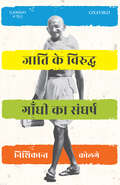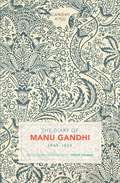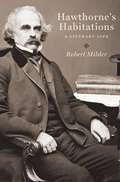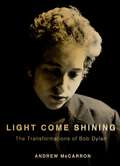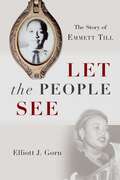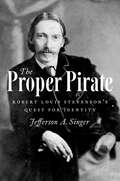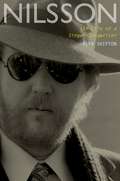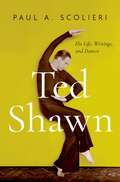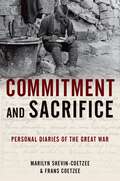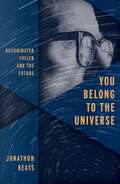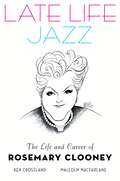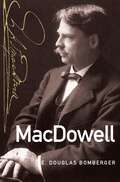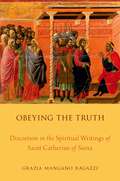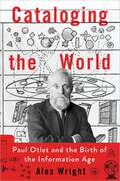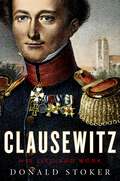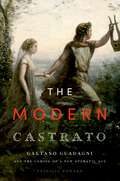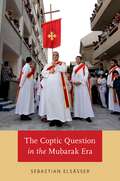- Table View
- List View
Jaati ke Viruddh Gandhi ka Sangharsh
by Nishikant KolgeIn 1909, while still in South Africa, Gandhi publicly decried the caste system for its inequalities. Shortly after his return to India though, he spoke of the generally beneficial aspects of caste. Gandhi's writings on caste reflect contradictory views and his critics accuse him of neglecting the unequal socio-economic structure that relegated Dalits to the bottom of the caste hierarchy. So, did Gandhi endorse the fourfold division of the Indian society or was he truly against caste? In this book, Nishikant Kolge investigates the entire range of what Gandhi said or wrote about caste divisions over a period of more than three decades: from his return to India in 1915 to his death in 1948. Interestingly, Kolge also maps Gandhi's own statements that undermined his stance against the caste system. These writings uncover the 'strategist Gandhi' who understood that social transformation had to be a slow process for the conservative but powerful section of Hindus who were not yet ready for radical reforms. Seven decades after it attained freedom from colonial powers, caste continues to influence the socio-political dynamics of India, and Gandhi against caste—the battle is not over yet.
The Diary of Manu Gandhi: 1943–1944
by Tridip SuhrudManu Gandhi, M.K. Gandhi’s grand-niece, joined him in 1943 at the age of fifteen. An aide to Gandhi’s ailing wife Kasturba in the Aga Khan Palace prison in Pune, Manu remained with him until his assassination. She was a partner in his final yajna, an experiment in Brahmacharya, and his invocation of Rama at the moment of his death. Spanning two volumes, The Diary of Manu Gandhi is a record of her life and times with M.K. Gandhi between 1943 and 1948. Authenticated by Gandhi himself, the meticulous and intimate entries in the diary throw light on Gandhi’s life as a prisoner and his endeavour to establish the possibility of collective non-violence. They also offer a glimpse into his ideological conflicts, his efforts to find his voice, and his lonely pilgrimage to Noakhali during the riots of 1946. The first volume (1943–44) chronicles the spiritual and educational pursuits of an adolescent woman who takes up writing as a mode of self-examination. The author shares a moving portrait of Kasturba Gandhi’s illness and death and also unravels the deep emotional bond she develops with Gandhi, whom she calls her ‘mother’.
Hawthorne's Habitations: A Literary Life
by Robert MilderThe first literary/biographical study of Hawthorne's full career in almost forty years, Hawthorne's Habitations presents a self-divided man and writer strongly attracted to reality for its own sake and remarkably adept at rendering it yet fearful of the nothingness he intuited at its heart. Making extensive use of Hawthorne's notebooks and letters as well as nearly all of his important fiction, Robert Milder's superb intellectual biography distinguishes between "two Hawthornes," then maps them onto the physical and cultural locales that were formative for Hawthorne's character and work: Salem, Massachusetts, Hawthorne's ancestral home and ingrained point of reference; Concord, Massachusetts, where came into contact with Emerson, Thoreau, and Margaret Fuller and absorbed the Adamic spirit of the American Renaissance; England, where he served for five years as consul in Liverpool, incorporating an element of Englishness; and Italy, where he found himself, like Henry James's expatriate Americans, confronted by an older, denser civilization morally and culturally at variance with his own.
Light Come Shining: The Transformations of Bob Dylan (Inner Lives)
by Andrew McCarronBob Dylan is the prince of self-reinvention and deflection. Whether it's the folkies of Greenwich Village, the student movement of the 1960s and 1970s, Born Again Christians, the Chabad Lubavitch community, or English Department postmodernists, specific intellectual and sociopolitical groups have repeatedly claimed Bob Dylan as their spokesperson. But in the words of filmmaker Todd Haynes, who cast six actors to depict different facets of Dylan's life and artistic personae in his 2009 film I'm Not There, "The minute you try to grab hold of Dylan, he's no longer where he was." In Light Come Shining, writer Andrew McCarron uses psychological tools to examine three major turning points - or transformations - in Bob Dylan's life: the aftermath of his 1966 motorcycle "accident," his Born Again conversion in 1978, and his recommitment to songwriting and performing in 1987. With fascinating insight, McCarron reveals how a common script undergirds Dylan's self-explanations of these changes; and, at the heart of this script, illuminates a fascinating story of spiritual death and rebirth that has captivated us all for generations.
Light Come Shining: The Transformations of Bob Dylan (Inner Lives)
by Andrew McCarronBob Dylan is the prince of self-reinvention and deflection. Whether it's the folkies of Greenwich Village, the student movement of the 1960s and 1970s, Born Again Christians, the Chabad Lubavitch community, or English Department postmodernists, specific intellectual and sociopolitical groups have repeatedly claimed Bob Dylan as their spokesperson. But in the words of filmmaker Todd Haynes, who cast six actors to depict different facets of Dylan's life and artistic personae in his 2009 film I'm Not There, "The minute you try to grab hold of Dylan, he's no longer where he was." In Light Come Shining, writer Andrew McCarron uses psychological tools to examine three major turning points - or transformations - in Bob Dylan's life: the aftermath of his 1966 motorcycle "accident," his Born Again conversion in 1978, and his recommitment to songwriting and performing in 1987. With fascinating insight, McCarron reveals how a common script undergirds Dylan's self-explanations of these changes; and, at the heart of this script, illuminates a fascinating story of spiritual death and rebirth that has captivated us all for generations.
Let the People See: The Story of Emmett Till
by Elliott J. GornThe world knows the story of young Emmett Till. In August 1955, the fourteen-year-old Chicago boy supposedly flirted with a white woman named Carolyn Bryant, who worked behind the counter of a country store, while visiting family in Mississippi. Three days later, his mangled body was recovered in the Tallahatchie River, weighed down by a cotton-gin fan. Till's killers, Bryant's husband and his half-brother, were eventually acquitted on technicalities by an all-white jury despite overwhelming evidence. It seemed another case of Southern justice. Then details of what had happened to Till became public, which they did in part because Emmett's mother, Mamie Till-Mobley, insisted that his casket remain open during his funeral. The world saw the horror, and Till's story gripped the country and sparked outrage. Black journalists drove down to Mississippi and risked their lives interviewing townsfolk, encouraging witnesses, spiriting those in danger out of the region, and above all keeping the news cycle turning. It continues to turn. In 2005, fifty years after the murder, the FBI reopened the case. New papers and testimony have come to light, and several participants, including Till's mother, have published autobiographies. Using this new evidence and a broadened historical context, Elliott J. Gorn delves more fully than anyone has into how and why the story of Emmett Till still resonates, and always will. Till's murder marked a turning point, Gorn shows, and yet also reveals how old patterns of thought and behavior endure, and why we must look hard at them.
Let the People See: The Story of Emmett Till
by Elliott J. GornThe world knows the story of young Emmett Till. In August 1955, the fourteen-year-old Chicago boy supposedly flirted with a white woman named Carolyn Bryant, who worked behind the counter of a country store, while visiting family in Mississippi. Three days later, his mangled body was recovered in the Tallahatchie River, weighed down by a cotton-gin fan. Till's killers, Bryant's husband and his half-brother, were eventually acquitted on technicalities by an all-white jury despite overwhelming evidence. It seemed another case of Southern justice. Then details of what had happened to Till became public, which they did in part because Emmett's mother, Mamie Till-Mobley, insisted that his casket remain open during his funeral. The world saw the horror, and Till's story gripped the country and sparked outrage. Black journalists drove down to Mississippi and risked their lives interviewing townsfolk, encouraging witnesses, spiriting those in danger out of the region, and above all keeping the news cycle turning. It continues to turn. In 2005, fifty years after the murder, the FBI reopened the case. New papers and testimony have come to light, and several participants, including Till's mother, have published autobiographies. Using this new evidence and a broadened historical context, Elliott J. Gorn delves more fully than anyone has into how and why the story of Emmett Till still resonates, and always will. Till's murder marked a turning point, Gorn shows, and yet also reveals how old patterns of thought and behavior endure, and why we must look hard at them.
The Proper Pirate: Robert Louis Stevenson's Quest for Identity
by Jefferson A. SingerExploring the life and times of author Robert Louis Stevenson, The Proper Pirate takes readers on a psychological journey from the writer's religious and constricted upbringing to a life of imagination and wonder culminating in the South Seas island of Samoa. Drawing on contemporary theories of identity development, Jefferson A. Singer traces how Stevenson overcame Victorian dualities of piety versus passion in both his personal life and artistic works, gradually edging toward a more Modernist and complicated moral vision. This first full-length psychobiographical study of Stevenson follows the trajectory of his life, all while highlighting how key memories and conflicts within his personality shaped the narrative structure and themes of some of his most celebrated works, including: Treasure Island, Strange Case of Dr. Jekyll and Mr. Hyde, A Child's Garden of Verses, and Kidnapped. Stevenson's relationships to his parents, his wife Fanny, and circle of intimate friends also play a prominent role in this investigation of his emerging identity and artistic body of work.
The Proper Pirate: Robert Louis Stevenson's Quest for Identity
by Jefferson A. SingerExploring the life and times of author Robert Louis Stevenson, The Proper Pirate takes readers on a psychological journey from the writer's religious and constricted upbringing to a life of imagination and wonder culminating in the South Seas island of Samoa. Drawing on contemporary theories of identity development, Jefferson A. Singer traces how Stevenson overcame Victorian dualities of piety versus passion in both his personal life and artistic works, gradually edging toward a more Modernist and complicated moral vision. This first full-length psychobiographical study of Stevenson follows the trajectory of his life, all while highlighting how key memories and conflicts within his personality shaped the narrative structure and themes of some of his most celebrated works, including: Treasure Island, Strange Case of Dr. Jekyll and Mr. Hyde, A Child's Garden of Verses, and Kidnapped. Stevenson's relationships to his parents, his wife Fanny, and circle of intimate friends also play a prominent role in this investigation of his emerging identity and artistic body of work.
Nilsson: The Life of a Singer-Songwriter
by Alyn ShiptonPaul McCartney and John Lennon described him as the Beatles' "favorite group," he won Grammy awards, wrote and recorded hit songs, and yet no figure in popular music is as much of a paradox, or as underrated, as Harry Nilsson. In this first ever full-length biography, Alyn Shipton traces Nilsson's life from his Brooklyn childhood to his Los Angeles adolescence and his gradual emergence as a uniquely talented singer-songwriter. With interviews from friends, family, and associates, and material drawn from an unfinished autobiography, Shipton probes beneath the enigma to discover the real Harry Nilsson. A major celebrity at a time when huge concerts and festivals were becoming the norm, Nilsson shunned live performance. His venue was the studio, his stage the dubbing booth, his greatest triumphs masterful examples of studio craft. He was a gifted composer of songs for a wide variety of performers, including the Ronettes, the Yardbirds, and the Monkees, yet Nilsson's own biggest hits were almost all written by other songwriters. He won two Grammy awards, in 1969 for "Everybody's Talkin'" (the theme song for Midnight Cowboy), and in 1972 for "Without You," had two top ten singles, numerous album successes, and wrote a number of songs--"Coconut" and "Jump into the Fire," to name just two--that still sound remarkably fresh and original today. He was once described by his producer Richard Perry as "the finest white male singer on the planet," but near the end of his life, Nilsson's career was marked by voice-damaging substance abuse and the infamous deaths of both Keith Moon and Mama Cass in his London flat. Drawing on exclusive access to Nilsson's papers, Alyn Shipton's biography offers readers an intimate portrait of a man who has seemed both famous and unknowable--until now.
Nilsson: The Life of a Singer-Songwriter
by Alyn ShiptonPaul McCartney and John Lennon described him as the Beatles' "favorite group," he won Grammy awards, wrote and recorded hit songs, and yet no figure in popular music is as much of a paradox, or as underrated, as Harry Nilsson. In this first ever full-length biography, Alyn Shipton traces Nilsson's life from his Brooklyn childhood to his Los Angeles adolescence and his gradual emergence as a uniquely talented singer-songwriter. With interviews from friends, family, and associates, and material drawn from an unfinished autobiography, Shipton probes beneath the enigma to discover the real Harry Nilsson. A major celebrity at a time when huge concerts and festivals were becoming the norm, Nilsson shunned live performance. His venue was the studio, his stage the dubbing booth, his greatest triumphs masterful examples of studio craft. He was a gifted composer of songs for a wide variety of performers, including the Ronettes, the Yardbirds, and the Monkees, yet Nilsson's own biggest hits were almost all written by other songwriters. He won two Grammy awards, in 1969 for "Everybody's Talkin'" (the theme song for Midnight Cowboy), and in 1972 for "Without You," had two top ten singles, numerous album successes, and wrote a number of songs--"Coconut" and "Jump into the Fire," to name just two--that still sound remarkably fresh and original today. He was once described by his producer Richard Perry as "the finest white male singer on the planet," but near the end of his life, Nilsson's career was marked by voice-damaging substance abuse and the infamous deaths of both Keith Moon and Mama Cass in his London flat. Drawing on exclusive access to Nilsson's papers, Alyn Shipton's biography offers readers an intimate portrait of a man who has seemed both famous and unknowable--until now.
Ted Shawn: His Life, Writings, and Dances
by Paul A. ScolieriTed Shawn (1891-1972) is the self-proclaimed "Father of American Dance" who helped to transform dance from a national pastime into theatrical art. In the process, he made dancing an acceptable profession for men and taught several generations of dancers, some of whom went on to become legendary choreographers and performers in their own right, most notably his protégés Martha Graham, Louise Brooks, Doris Humphrey, and Charles Weidman. Shawn tried for many years and with great frustration to tell the story of his life's work in terms of its social and artistic value, but struggled, owing to the fact that he was homosexual, a fact known only within his inner circle of friends. Unwilling to disturb the meticulously narrated account of his paternal exceptionalism, he remained closeted, but scrupulously archived his journals, correspondence, programs, photographs, and motion pictures of his dances, anticipating that the full significance of his life, writing, and dances would reveal itself in time. Ted Shawn: His Life, Writings, and Dances is the first critical biography of the dance legend, offering an in-depth look into Shawn's pioneering role in the formation of the first American modern dance company and school, the first all-male dance company, and Jacob's Pillow, the internationally renowned dance festival and school located in the Berkshires. The book explores Shawn's writings and dances in relation to emerging discourses of modernism, eugenics and social evolution, revealing an untold story about the ways that Shawn's homosexuality informed his choreographic vision. The book also elucidates the influences of contemporary writers who were leading a radical movement to depathologize homosexuality, such as the British eugenicist Havelock Ellis and sexologist Alfred Kinsey, and conversely, how their revolutionary ideas about sexuality were shaped by Shawn's modernism.
Ted Shawn: His Life, Writings, and Dances
by Paul A. ScolieriTed Shawn (1891-1972) is the self-proclaimed "Father of American Dance" who helped to transform dance from a national pastime into theatrical art. In the process, he made dancing an acceptable profession for men and taught several generations of dancers, some of whom went on to become legendary choreographers and performers in their own right, most notably his protégés Martha Graham, Louise Brooks, Doris Humphrey, and Charles Weidman. Shawn tried for many years and with great frustration to tell the story of his life's work in terms of its social and artistic value, but struggled, owing to the fact that he was homosexual, a fact known only within his inner circle of friends. Unwilling to disturb the meticulously narrated account of his paternal exceptionalism, he remained closeted, but scrupulously archived his journals, correspondence, programs, photographs, and motion pictures of his dances, anticipating that the full significance of his life, writing, and dances would reveal itself in time. Ted Shawn: His Life, Writings, and Dances is the first critical biography of the dance legend, offering an in-depth look into Shawn's pioneering role in the formation of the first American modern dance company and school, the first all-male dance company, and Jacob's Pillow, the internationally renowned dance festival and school located in the Berkshires. The book explores Shawn's writings and dances in relation to emerging discourses of modernism, eugenics and social evolution, revealing an untold story about the ways that Shawn's homosexuality informed his choreographic vision. The book also elucidates the influences of contemporary writers who were leading a radical movement to depathologize homosexuality, such as the British eugenicist Havelock Ellis and sexologist Alfred Kinsey, and conversely, how their revolutionary ideas about sexuality were shaped by Shawn's modernism.
Commitment and Sacrifice: Personal Diaries from the Great War
by Marilyn Shevin-Coetzee Frans CoetzeeFor years, those who attempted to understand the devastation of World War I looked to the collections of diplomatic documents, the stirring speeches, and the partisan memoirs of the leading participants. However, those accounts offered little by way of the intimate history, or the individual experiences of those involved in the Great War. In Commitment and Sacrifice, Marilyn Shevin-Coetzee and Frans Coetzee provide just such an "intimate look" by bringing together previously unpublished diaries of five participants in the First World War and restoring to publication the diary of a sixth that has long been out of print. The six diaries address the war on the Western front and the Mediterranean, as well as behind the lines on the home front. Together, these diarists form a diverse group: John French, a British sapper who dug precarious tunnels beneath the trenches of the Western Front; Henri Desagneaux, a French infantry officer embroiled in years of bloody combat; Philip T. Cate, an idealistic American volunteer ambulance driver who sought to save lives rather than take them; Willy Wolff, a German businessman caught in England upon the war's outbreak and interned there for the duration; James Douglas Hutchison, a New Zealand artilleryman fighting thousands of miles from home; and Felix Kaufmann, a German machine gunner, captured and held as a prisoner of war. Through the personal reflections of these young men, we are transported into many of the iconic episodes of the war, from the upheaval of mobilization through the great battles of Gallipoli, Verdun, and the Somme, as well as the less familiar "other ordeal" of internment and captivity. As members of the so-called Generation of 1914 (each was between nineteen and twenty-four years old), they shared an unwavering commitment to their countries' cause, and possessed a steadfast determination to persevere despite often appalling circumstances. Collectively, these diaries illuminate the sacrifices of war, whether willingly volunteered or stoically endured. That the diarists had the desire and the ingenuity to record their experiences, whether for their families, posterity, or simply their own personal satisfaction, gives readers the ability to eavesdrop on horrors long past. A century later, we are fortunate that they were both willing and able to set pencil to paper.
Commitment and Sacrifice: Personal Diaries from the Great War
by Marilyn Shevin-Coetzee Frans CoetzeeFor years, those who attempted to understand the devastation of World War I looked to the collections of diplomatic documents, the stirring speeches, and the partisan memoirs of the leading participants. However, those accounts offered little by way of the intimate history, or the individual experiences of those involved in the Great War. In Commitment and Sacrifice, Marilyn Shevin-Coetzee and Frans Coetzee provide just such an "intimate look" by bringing together previously unpublished diaries of five participants in the First World War and restoring to publication the diary of a sixth that has long been out of print. The six diaries address the war on the Western front and the Mediterranean, as well as behind the lines on the home front. Together, these diarists form a diverse group: John French, a British sapper who dug precarious tunnels beneath the trenches of the Western Front; Henri Desagneaux, a French infantry officer embroiled in years of bloody combat; Philip T. Cate, an idealistic American volunteer ambulance driver who sought to save lives rather than take them; Willy Wolff, a German businessman caught in England upon the war's outbreak and interned there for the duration; James Douglas Hutchison, a New Zealand artilleryman fighting thousands of miles from home; and Felix Kaufmann, a German machine gunner, captured and held as a prisoner of war. Through the personal reflections of these young men, we are transported into many of the iconic episodes of the war, from the upheaval of mobilization through the great battles of Gallipoli, Verdun, and the Somme, as well as the less familiar "other ordeal" of internment and captivity. As members of the so-called Generation of 1914 (each was between nineteen and twenty-four years old), they shared an unwavering commitment to their countries' cause, and possessed a steadfast determination to persevere despite often appalling circumstances. Collectively, these diaries illuminate the sacrifices of war, whether willingly volunteered or stoically endured. That the diarists had the desire and the ingenuity to record their experiences, whether for their families, posterity, or simply their own personal satisfaction, gives readers the ability to eavesdrop on horrors long past. A century later, we are fortunate that they were both willing and able to set pencil to paper.
You Belong to the Universe: Buckminster Fuller and the Future
by Jonathon KeatsA compelling call to apply Buckminster Fuller's creative problem-solving to present-day problems A self-professed "comprehensive anticipatory design scientist," the inventor Buckminster Fuller (1895-1983) was undoubtedly a visionary. Fuller's creations often bordered on the realm of science fiction, ranging from the freestanding geodesic dome to the three-wheel Dymaxion car to a bathroom requiring neither plumbing nor sewage. Yet in spite of his brilliant mind and life-long devotion to serving mankind, Fuller's expansive ideas were often dismissed, and have faded from public memory since his death. You Belong to the Universe documents Fuller's six-decade quest to "make the world work for one hundred percent of humanity." Critic and experimental philosopher Jonathon Keats sets out to revive Fuller's unconventional practice of comprehensive anticipatory design, placing Fuller's philosophy in a modern context and dispelling much of the mythology surrounding Fuller's life. Keats argues that Fuller's life and ideas, namely doing "the most with the least," are now more relevant than ever as humanity struggles to meet the demands of an exploding world population with finite resources. Delving deeply into Buckminster Fuller's colorful world, Keats applies Fuller's most important concepts to present-day issues, arguing that his ideas are now not only feasible, but necessary. From transportation to climate change, urban design to education, You Belong to the Universe demonstrates that Fuller's holistic problem-solving techniques may be the only means of addressing some of the world's most pressing issues. Keats's timely book challenges each of us to become comprehensive anticipatory design scientists, providing the necessary tools for continuing Fuller's legacy of improving the world.
You Belong to the Universe: Buckminster Fuller and the Future
by Jonathon KeatsA compelling call to apply Buckminster Fuller's creative problem-solving to present-day problems A self-professed "comprehensive anticipatory design scientist," the inventor Buckminster Fuller (1895-1983) was undoubtedly a visionary. Fuller's creations often bordered on the realm of science fiction, ranging from the freestanding geodesic dome to the three-wheel Dymaxion car to a bathroom requiring neither plumbing nor sewage. Yet in spite of his brilliant mind and life-long devotion to serving mankind, Fuller's expansive ideas were often dismissed, and have faded from public memory since his death. You Belong to the Universe documents Fuller's six-decade quest to "make the world work for one hundred percent of humanity." Critic and experimental philosopher Jonathon Keats sets out to revive Fuller's unconventional practice of comprehensive anticipatory design, placing Fuller's philosophy in a modern context and dispelling much of the mythology surrounding Fuller's life. Keats argues that Fuller's life and ideas, namely doing "the most with the least," are now more relevant than ever as humanity struggles to meet the demands of an exploding world population with finite resources. Delving deeply into Buckminster Fuller's colorful world, Keats applies Fuller's most important concepts to present-day issues, arguing that his ideas are now not only feasible, but necessary. From transportation to climate change, urban design to education, You Belong to the Universe demonstrates that Fuller's holistic problem-solving techniques may be the only means of addressing some of the world's most pressing issues. Keats's timely book challenges each of us to become comprehensive anticipatory design scientists, providing the necessary tools for continuing Fuller's legacy of improving the world.
Late Life Jazz: The Life and Career of Rosemary Clooney
by Ken Crossland Malcolm MacfarlaneWhen people hear the name "Clooney," they automatically think of George Clooney, one of Hollywood's biggest stars. But it was his aunt Rosemary who first catapulted the name into bright lights with a string of hit songs in the 1950s and a starring role alongside Bing Crosby in the immortal "White Christmas." Drawing on interviews with family members, managers, promoters, and the jazz musicians who worked with her, as well as contemporary newspaper articles and reviews, Late Life Jazz tells the unsung story of one of America's finest singers, Rosemary Clooney. Ken Crossland and Malcolm Macfarlane trace Rosemary's life from her hardscrabble beginnings in Maysville Kentucky, through her first performances singing with the Barney Rapp Band in Cincinnati, through her rise to pop stardom in the early 1950s when she topped the Hit Parade with songs such as "Come On-a My House," "Tenderly," and "Half As Much." By the time the 1960s arrived, however, personal turmoil, fueled by depression and an addiction to prescription medication, almost destroyed Clooney's career-and her life. She underwent years of therapy and recuperation before she was able to perform again in the early 1970s. Few expected her to be anything more than a baroness of nostalgia, but Rosemary had other ideas. Rejuvenated by a series of concerts alongside her friend and mentor, Bing Crosby, she found a new medium in the midst of America's finest jazz musicians, building a second career and with it a reputation as one of the finest interpreters of the Great American Songbook. Vividly written and painstakingly researched, Late Life Jazz explores the rise, fall, and final triumph of Clooney the First, Aunt Rosemary, jazz singer par excellence.
MacDowell: Essays On Edward Macdowell (Master Musicians Series #5)
by E. Douglas BombergerEdward MacDowell was born on the eve of the Civil War into a Quaker family in lower Manhattan, where music was a forbidden pleasure. With the help of Latin-American émigré teachers, he became a formidable pianist and composer, spending twelve years in France and Germany establishing his career. Upon his return to the United States in 1888 he conquered American audiences with his dramatic Second Piano Concerto and won his way into their hearts with his poetic Woodland Sketches. Columbia University tapped him as their first professor of music in 1896, but a scandalous row with powerful university president Nicholas Murray Butler spelled the end of his career. MacDowell died a broken man four years later, but his widow Marian kept his spirit alive through the MacDowell Colony, which she founded in 1907 in their New Hampshire home, and which is today the oldest and one of the most influential, thriving artist colonies in the the United States. Drawing on private letters that were sealed for fifty years after his death, this biography traces MacDowell's compelling life story, with new revelations about his Quaker childhood, his efforts to succeed in the insular German music world, his mysterious death, and his lifelong struggle with Seasonal Affective Disorder. Edward MacDowell's story is a timeless tale of human strength and weakness set in one of the most vibrant periods of American musical history, when optimism about the country's artistic future made anything seem possible.
Obeying The Truth: Discretion In The Spiritual Writings Of Saint Catherine Of Siena
by Grazia Mangano RagazziCataloging the World: Paul Otlet and the Birth of the Information Age
by Alex WrightThe dream of capturing and organizing knowledge is as old as history. From the archives of ancient Sumeria and the Library of Alexandria to the Library of Congress and Wikipedia, humanity has wrestled with the problem of harnessing its intellectual output. The timeless quest for wisdom has been as much about information storage and retrieval as creative genius. In Cataloging the World, Alex Wright introduces us to a figure who stands out in the long line of thinkers and idealists who devoted themselves to the task. Beginning in the late nineteenth century, Paul Otlet, a librarian by training, worked at expanding the potential of the catalog card, the world's first information chip. From there followed universal libraries and museums, connecting his native Belgium to the world by means of a vast intellectual enterprise that attempted to organize and code everything ever published. Forty years before the first personal computer and fifty years before the first browser, Otlet envisioned a network of "electric telescopes" that would allow people everywhere to search through books, newspapers, photographs, and recordings, all linked together in what he termed, in 1934, a réseau mondial--essentially, a worldwide web. Otlet's life achievement was the construction of the Mundaneum--a mechanical collective brain that would house and disseminate everything ever committed to paper. Filled with analog machines such as telegraphs and sorters, the Mundaneum--what some have called a "Steampunk version of hypertext"--was the embodiment of Otlet's ambitions. It was also short-lived. By the time the Nazis, who were pilfering libraries across Europe to collect information they thought useful, carted away Otlet's collection in 1940, the dream had ended. Broken, Otlet died in 1944. Wright's engaging intellectual history gives Otlet his due, restoring him to his proper place in the long continuum of visionaries and pioneers who have struggled to classify knowledge, from H.G. Wells and Melvil Dewey to Vannevar Bush, Ted Nelson, Tim Berners-Lee, and Steve Jobs. Wright shows that in the years since Otlet's death the world has witnessed the emergence of a global network that has proved him right about the possibilities--and the perils--of networked information, and his legacy persists in our digital world today, captured for all time.
Clausewitz: His Life and Work
by Donald StokerCarl von Clausewitz's masterwork, On War, is generally considered the greatest text on military theory ever written. Clausewitz is a touchstone for the field today, and is read by scholars, students, and military personnel around the world. And yet to Clausewitz himself, far more important than achieving recognition for his scholarly and theoretical contributions was achieving glory on the field of battle-winning renown not with his pen but with his sword. Military historian Donald Stoker's perceptive biography of Carl von Clausewitz moves skillfully between Clausewitz's career as a soldier and his work as a theoretician and author, exploring the composition of On War and other works while also emphasizing the many military engagements in which Clausewitz fought. Though Clausewitz certainly spilled his share of ink, he also spilled blood--his as well as that of the enemy. As an officer in the Prussian army, Clausewitz fought in battles from Jena-Auerstedt to Waterloo, as well as the battle of Borodino while serving the Russians. Stoker takes readers through the heat of these battles, providing historical overview and discussing each engagement in detail. Rich context is provided by Clausewitz himself, who wrote abundant letters to his wife and friends throughout his life, and from which Stoker draws extensively. Clausewitz argues for the centrality of Clausewitz's work as a soldier, but it does not neglect his historical achievements in military theory. Stoker unpacks each of Clausewitz's significant works, considering their influences and describing the circumstances around their composition. The interplay between the biographical details of Clausewitz's life and the arguments put forth in his written works allows for a deeper understanding of these familiar texts, and Stoker's insightful commentary adds depth to the discussion. The result is an absorbing reassessment of both the man and his legacy, and a significant contribution to the study of Clausewitz and his place in today's military and political landscape.
Clausewitz: His Life and Work
by Donald StokerCarl von Clausewitz's masterwork, On War, is generally considered the greatest text on military theory ever written. Clausewitz is a touchstone for the field today, and is read by scholars, students, and military personnel around the world. And yet to Clausewitz himself, far more important than achieving recognition for his scholarly and theoretical contributions was achieving glory on the field of battle-winning renown not with his pen but with his sword. Military historian Donald Stoker's perceptive biography of Carl von Clausewitz moves skillfully between Clausewitz's career as a soldier and his work as a theoretician and author, exploring the composition of On War and other works while also emphasizing the many military engagements in which Clausewitz fought. Though Clausewitz certainly spilled his share of ink, he also spilled blood--his as well as that of the enemy. As an officer in the Prussian army, Clausewitz fought in battles from Jena-Auerstedt to Waterloo, as well as the battle of Borodino while serving the Russians. Stoker takes readers through the heat of these battles, providing historical overview and discussing each engagement in detail. Rich context is provided by Clausewitz himself, who wrote abundant letters to his wife and friends throughout his life, and from which Stoker draws extensively. Clausewitz argues for the centrality of Clausewitz's work as a soldier, but it does not neglect his historical achievements in military theory. Stoker unpacks each of Clausewitz's significant works, considering their influences and describing the circumstances around their composition. The interplay between the biographical details of Clausewitz's life and the arguments put forth in his written works allows for a deeper understanding of these familiar texts, and Stoker's insightful commentary adds depth to the discussion. The result is an absorbing reassessment of both the man and his legacy, and a significant contribution to the study of Clausewitz and his place in today's military and political landscape.
The Modern Castrato: Gaetano Guadagni and the Coming of a New Operatic Age
by Patricia HowardThe Modern Castrato: Gaetano Guadagni and the Coming of a New Operatic Age chronicles the career of the most significant castrato of the second half of the eighteenth-century. Through a coincidence of time and place, Gaetano Guadagni was on the forefront of the heroic opera reform, and many forward-thinking composers of the age created roles for him. Author Patricia Howard reveals that Guadagni may have been the only singer of the time fully able to understand the demands and opportunities of this reform, as well to possess the intelligence and self-knowledge to realize that it suited his skills, limitations and temperament perfectly--making him the first castrato to embrace the concepts of modern singing. The first full-length biography of this outstanding singer, The Modern Castrato illuminates the everyday lives of eighteenth-century singers while spotlighting the historic high points of the century. Most famous for his creation of the role of Orpheus in Gluck's Orfeo ed Euridice, his career ranged widely and brought him into contact with many progressives theorists and composers such as Traetta, Jommelli, and Bertoni. Howard's focus on the development of Guadagni's career pauses on essential, related topics along the way, such as the castrato in society, the eighteenth-century revolution in acting, and the remarkable evidence for Guadagni's marionette theater. Howard also assesses Guadagni's surviving compositions, which give new insight into the quality and character of his voice as well as his technical and expressive abilities. The Modern Castrato is an engaging narrative that will prove essential reading for opera lovers and scholars of eighteenth-century music.
